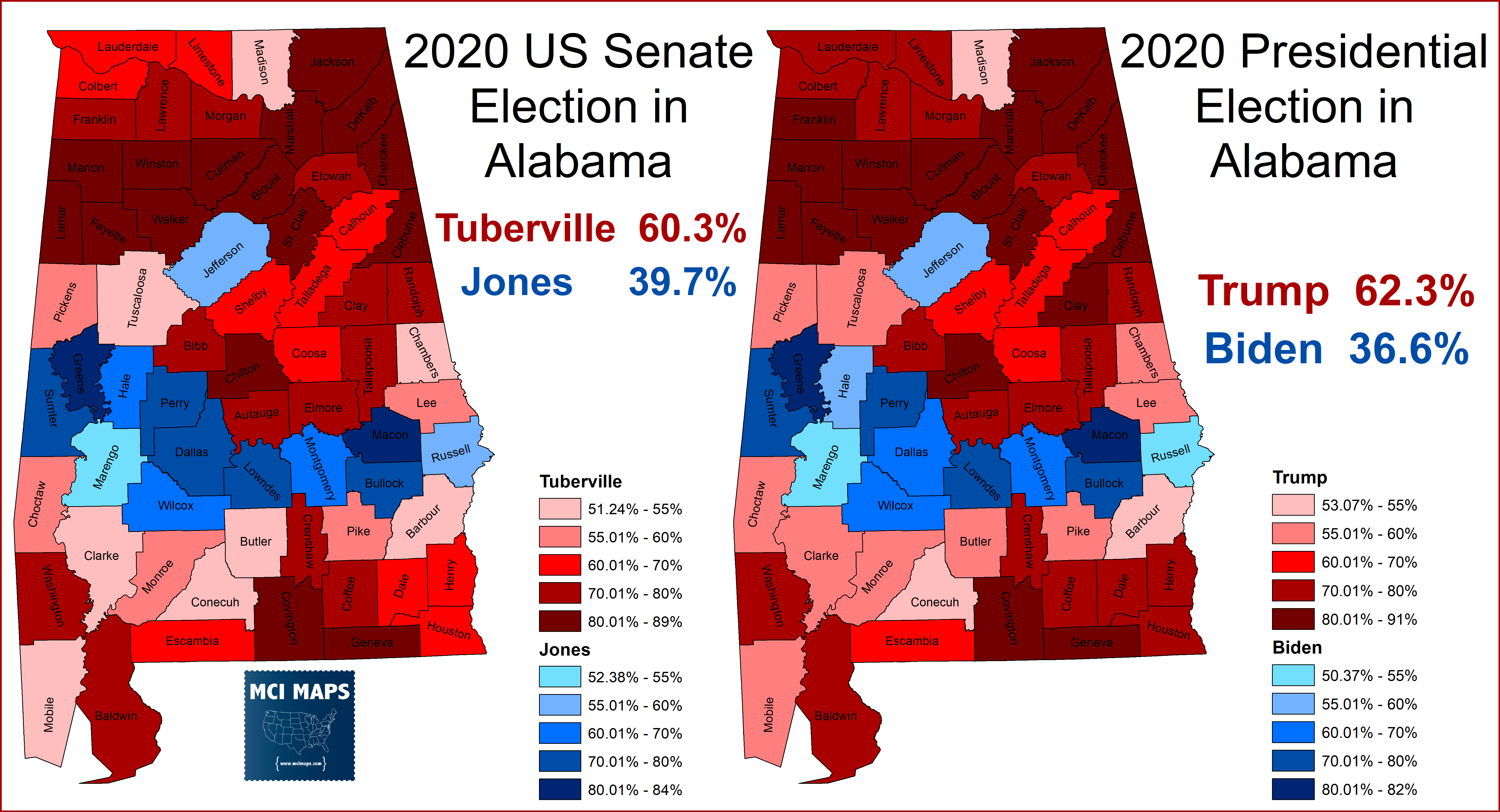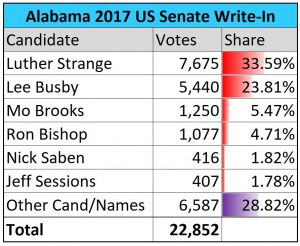The 2020 Senate Elections were a mixed bag for Democrats. The party was hoping to flip the senate by making several gains across the country. In the end, however, they only flipped Colorado and Arizona. They still have an outside shot to win both Georgia runoffs. However, they will need both to tie the Senate. One thing that hurt them in their quest to take back the chamber was the loss of Senator Doug Jones in Alabama. Jones’ loss was largely predicted. Jones shocked the world with his 2017 special election victory and was the only Democratic Senator from a deep south state. He had a very tough re-election prospect ahead of him. In the wake of his loss, I want to take a look back at his 2017 victory and why his re-election was practically doomed from the start.
The 2017 Miracle
When Donald Trump won the Presidency in 2016, he named Alabama Senator Jeff Sessions to be his Attorney General. This set off a chain reaction in Alabama. Then-Governor Robert Bentley appointed Alabama Attorney General Luther Strange to be Senator – with a special election to finish the term scheduled for the 2018 midterm. Bentley was already under investigation for ethics and finance crimes related to covering up an extramarital affair. It was rumored Strange scuttled investigation to gain favor for the Senate appointment. This rumbling would cloud Strange’s Senate tenure.
Bentley was eventually forced to resign in April of 2017 and Lt Governor Kay Ivey assumed the office. She opted to change the date of the special election – moving it to December of 2017. This set up a short campaign for the Senate seat.
On the Democratic side, the star recruit was former US Attorney Doug Jones. Serving in the 1990s, Jones was able to bring charges and conviction to KKK leaders who had been part of the 1963 Birmingham Church bombings. Jones had strong appeal in the African-American community and his time as a prosecutor made him a very appealing Democrat. Of course, this would still be an uphill climb in Alabama. The state is heavily racially polarized and the state had not elected a Democrat to the US Senate since the 1990s. Democratic support was often confined to the black belt and a few counties with larger college-educated voters.
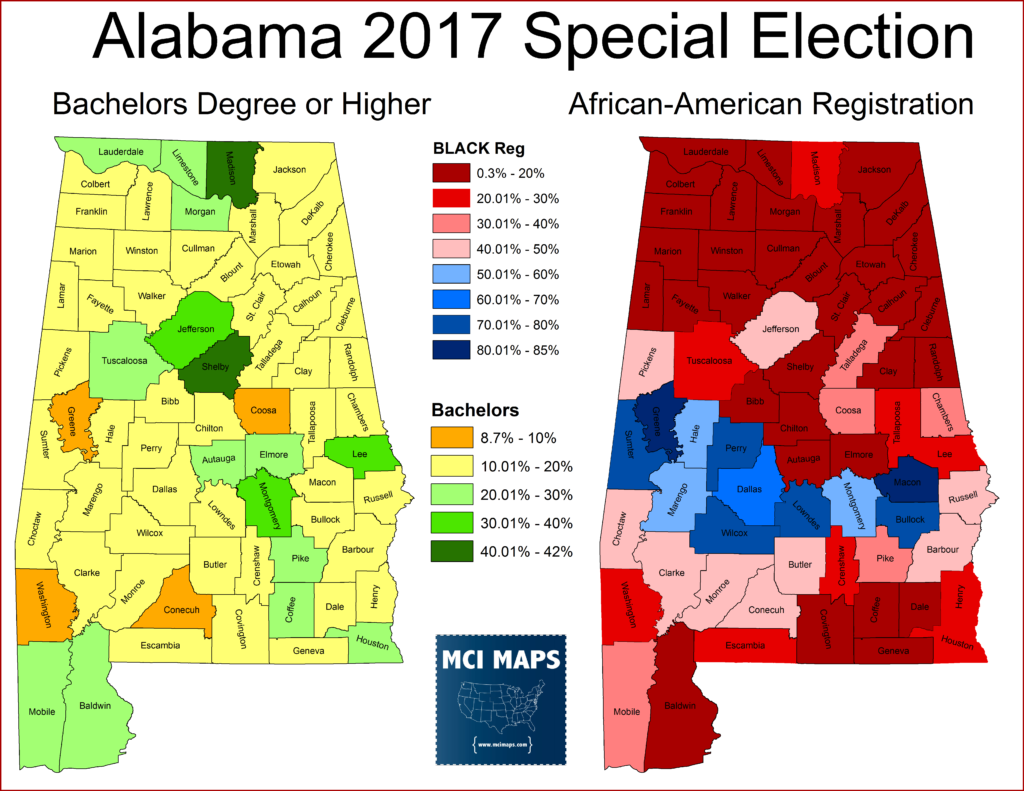
Jones was considered a strong recruit but the race was still heavily expected to be a Republican win. The drama really was focused on the GOP primary.
Roy More Crashes the Party
The goal for the Republican Party from day one was protecting Luther Strange. Mitch McConnell made it clear that the NRSC would back Strange and worked to discourage any mainstream challengers. However, the efforts to clear the field were unsuccessful. Congressman Mo Brooks of the Alabama 5th district filed to run. In addition, former Supreme Court Justice Roy Moore also filed. Moore had been Chief Justice of the Alabama Supreme Court and was removed TWICE! The first time was for refusing to remove a monument of the Ten Commandments from the Court, the second time for refusing to recognize and honor same-sex marriage in the state.
Republicans made blocking Brooks their top priority. McConnell and other operatives believed Moore would be easier to defeat in a runoff (required if no one gets 50%). However, Strange proved weaker than expected – likely weighed down by his association with former Governor Bentley. Strange and Moore advanced, but with Moore in first. The GOP efforts to stop Moore with just a few weeks till the runoff came up short. Even with Trump’s backing, Strange lost to Moore.
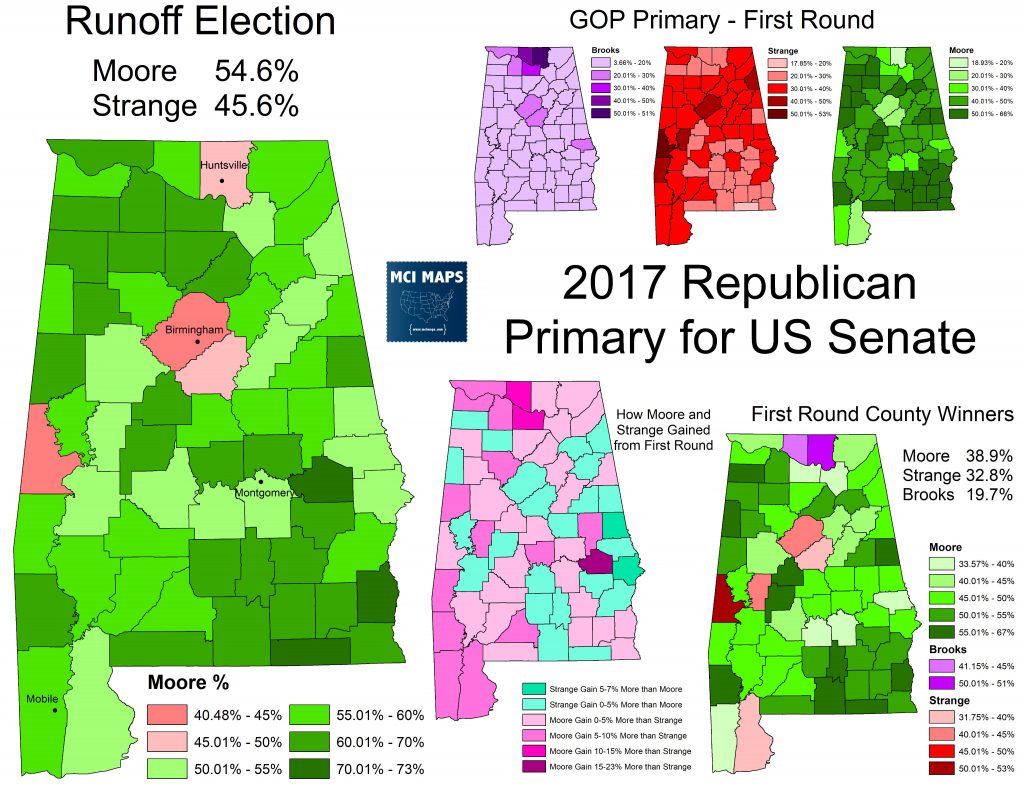
With the runoff over, the GOP was stuck with Roy Moore as their nominee. However, it was still clear Moore was favored to win. Most discussion focused on how hard Moore would be for the Republicans to control once he was in the Senate.
The General Election
Through most of the general election campaign Moore maintained a lead in the polls – albeit a modest one. The race, however, got turned on its head in November when reports emerged that Moore had targeted, harassed, and assaulted young girls (14 to 16) when he was in his 30s. The revelations, backed up by multiple women, caused a firestorm in Alabama. The revelations resulted in many Republicans pulling their support – but Trump maintained his support for Moore. The revelations caused polls to tighten considerably in the race. (Graph from wikipedia).
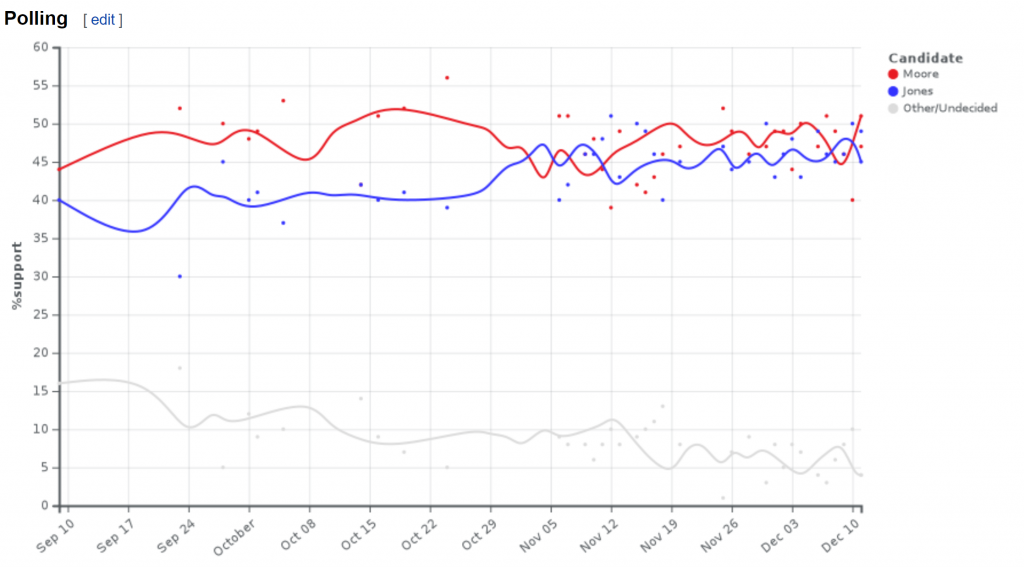
Many Republicans thought of ways to prevent defeat – from write-in campaign for Strange to asking Ivey to delay the election. Nothing came of either. Heading into election day, the race was considered a tossup. Moore was heavily damaged by the accusations and many Republicans pledged to write-in someone else or simply stay home. This was the only race on the ballot after all – many could simply sit the race out.
The results came in, and after a close count the whole night, Jones was confirmed the winner in a stunning upset. It marked the first time a Democrat had won federal statewide office in Alabama since the 1990s.

The turnout turning the general election reveal that many white Republicans indeed stayed home on election day. Turnout was strongest in democratic areas – especially along the black belt. The counties with larger black populations had a much higher share of their 2016 vote casting ballots in the special.

Write-in ballots technically made up more than the gap between Moore and Jones, though the Democrat came just under 50%. A look at the write-in ballots showed Luther Stange got the highest share. Lee Busby – who launched a write-in campaign after the Moore scandal broke, came in 2nd among these voters.
I delved into these results more in the article I wrote the night of Jones’s victory. So I encourage you to check that out. But by an large Jones was propelled not just by cross-over Republican support – but also by many white Republicans staying home while Democrats showing up. This was a unique turnout scenario that was only possible because it was a stand-alone special election. Had the race taken place in the 2018 midterm – with other races on the ballot – it would be easy to see Jones losing.
Jones in the Senate
Once Jones entered the Senate, he largely voted in line with the Democratic Party. Despite being from a solidly red state, Jones broke with the party on fewer issues than most may expect. He was quick to make his opposition to Trump’s Supreme Court nominee, Brett Kavanaugh, known and rarely broke with the party on pressing issues. By large Jones acted like a man who knew his time in the Senate was likely temporary. He also knew he had to keep the Democratic base of Alabama energized to turn out in 2020.
Jones was in a bad position in 2020. Even as Moore made it clear he’d run again, their was a good chance a rematch could lead to Jones still losing. The turnout dynamics of the special election just couldn’t be replicated in a regular election. I made my thoughts clear in 2019.
Likely knowing this himself, the Senator didn’t seek to alienate people in the party. He was a reliable member of the Democratic caucus.
The 2020 Campaign
Doug Jones was always going to be a top target in 2020. The 2018 midterms did not bode well for Jones either. That year had seen Democratic incumbents in North Dakota, Indiana, and Missouri fall due to the partisan lean of their state – all despite a general blue wave. Race raters were iffy on Jones’ prospects. By October of 2019 his race was ranked as Lean Republican by Crystal Ball. It went to Likely Republican in 2020. The first question was, who would he face?
GOP Primary
There were many candidates aiming for a shot at Jones. Many candidates also wanted to see what Jeff Sessions would do. Sessions was fired by Trump shortly after the 2018 midterm and many suspected he wanted to go back to the Senate. However, it was speculated Trump would endorse an opponent to get revenge on Sessions recusing himself in the Russia investigation. Sessions’ recusal, which set the stage for Robert Muller to run the investigation into collusions with the Russians, angered Trump and permanently damaged the relationship between Sessions and the President.
In the end, Sessions did opt to make a bid for the office. He did not clear the field, however, as Congressman Bradley Byrne and former Auburn Couch Tommy Tuberville were running as well. Roy Moore decided to run as well, but had much more muted support this go around – with Trump himself kneecapping Moore’s candidacy by calling on voters not to pick him. The main candidates were Tuberville, Sessions, and Byrne. Sessions found himself struggling to win over support from conservatives who felt he betrayed Trump. Tuberville, meanwhile, went to the hard populist right to appeal to rural whites.
When the March primary came around, Tuberville came in a narrow first place, with Sessions close behind. A runoff would normally take place in a few short weeks, but the worsening COVID-19 pandemic delayed it till July. This was good for Sessions in that it gave him more time to make his case. However, Trump backed Tuberville and attacked Sessions. As a result, Tuberville secured a 20 point win in the runoff.
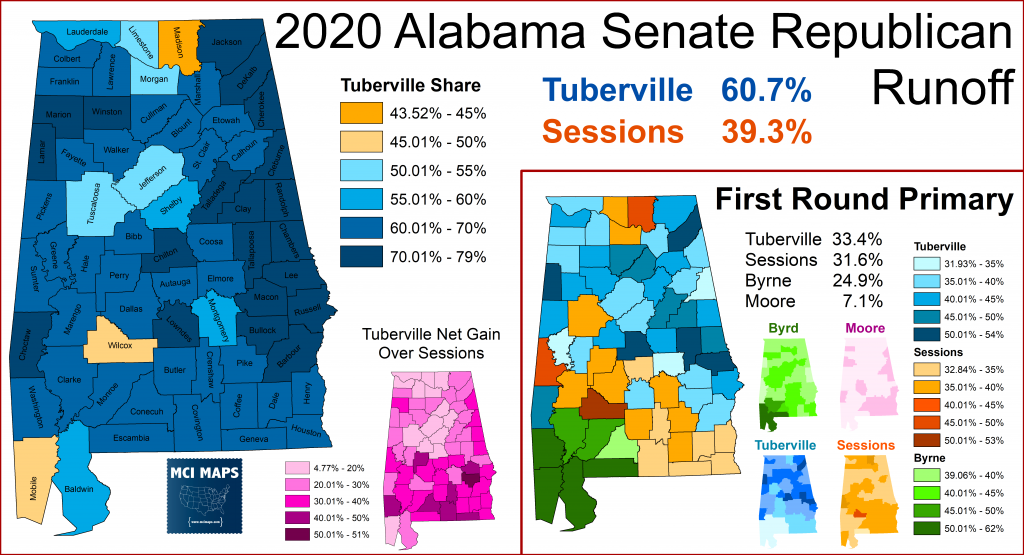
With the primary over, it was Tuberville vs Jones in the general.
General Election
The general election was a pretty standard affair. No major scandals emerged and Jones ran a tough and well financed campaign. Tuberville, however, maintained constant leads in the polls – often just slightly underperforming the top of the ticket. Partisanship was just too strong a force in the state. In the end, Jones would lose by 20 points – which was still better than Biden’s 26 point loss.
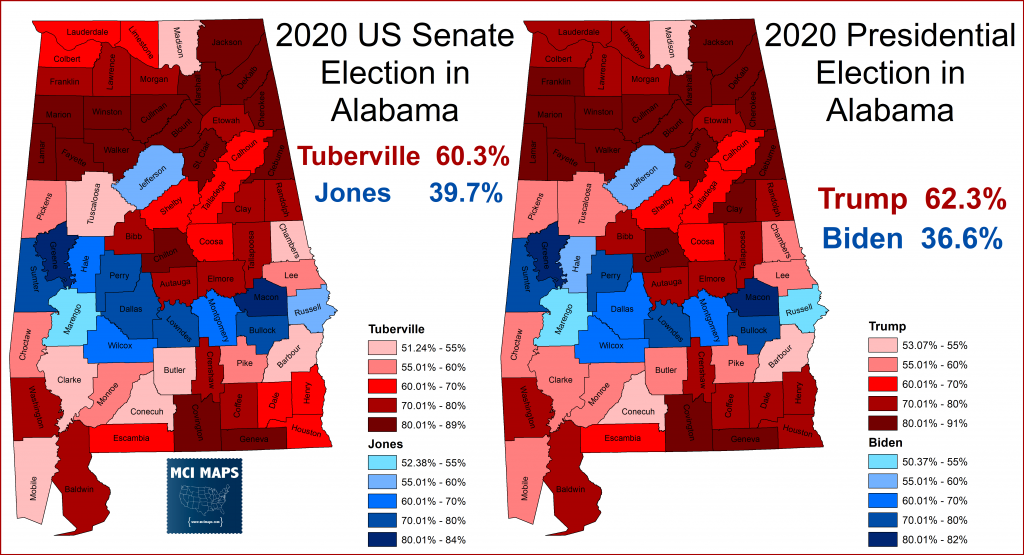
Jones underperformed his 2017 performance in every county. Though his biggest losses where in some of the suburbs where he had stronger crossover support in 2017, he had drops in college towns as well. Part of that could be both Tuberville’s Auburb ties and also the COVID effect on campus attendance. Jones did, however, overperform Biden across the board.
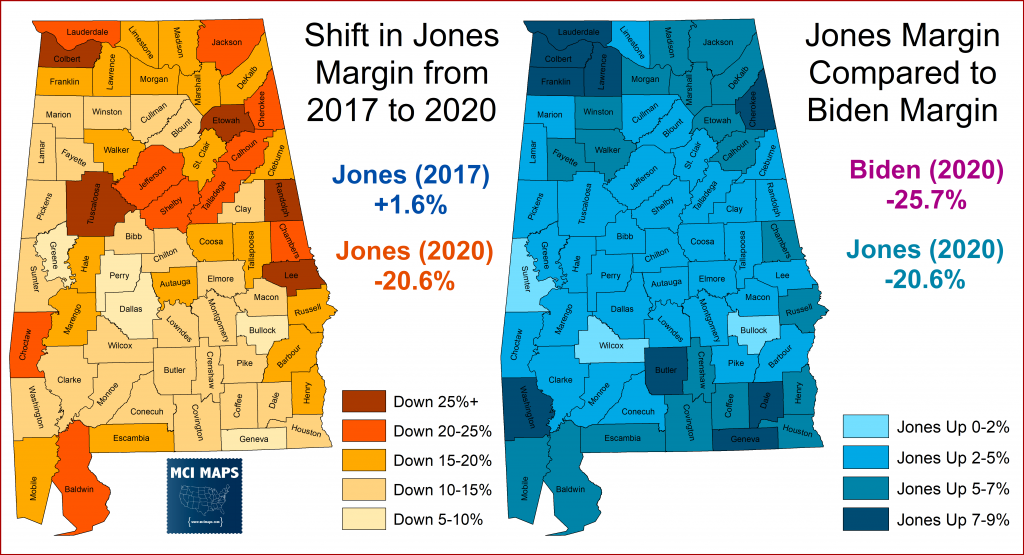
The turnout dynamics of 2017 resulted in an expected surge in votes from whiter counties compared to the special. Meanwhile, votes increased only modestly in the black belt – despite the belt overall holding decent turnout compared to the rest of the state. In the end, the black belt counties just had fewer non-voters from 2017 to turn out.

This turnout situation made things worse for Jones – as his support was largely relegated to counites with larger black populations. Without getting stronger cross-party voting – the surge in turnout in the white counties meant he was just losing more votes.
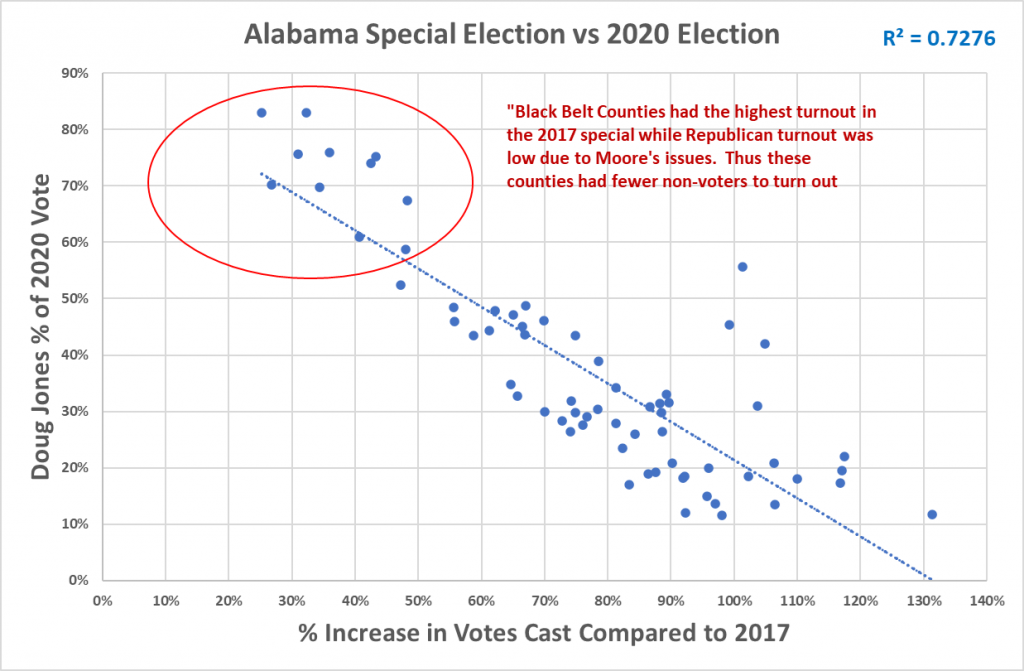
You can see the turnout dynamics in the table below. In the 2016 Presidential election, turnout in the 70%+ black counties were near even with the rest of the state (in fact a little lower). This was also true in 2020. However, that 2017 special saw black turnout surpass white. This dynamic just could never be replicated in a regular election.

While Jones was going to be doomed anyway due to a lack of large ticket splitting, the turnout dynamic also would have made any victory near impossible.
Conclusion
Jones’ loss comes as no real surprise to most of us. He ran a strong campaign in 2017, to be sure. However, his win was aided by the problems of Moore and the turnout dynamics that a special election allowed. Jones should get tremendous credit for being a good Democrat in the Senate and not trying to sell the party out to possibly cling to his seat even though re-election was virtually impossible. In the end his loss was tragic but just the grim reality of our partisan climate.
Lets all hope he gets to be Biden’s Attorney General.

